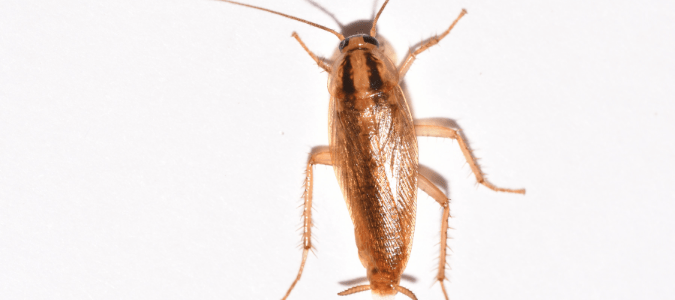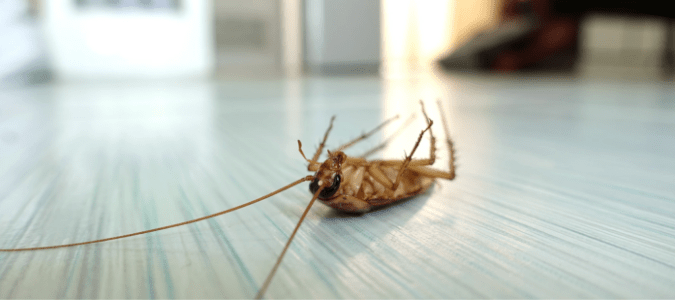There are around 4,500 cockroach species worldwide, of which 70 are in the United States. One of the most common types is the German roach. German roaches need human activity to survive and thrive. These roaches usually infest people’s homes, ruining food and spreading diseases.
What do German roaches look like? Here is a guide to help you identify this type of cockroach. We cover its appearance, where it comes from and how it invades. You’ll also learn about steps you can take to address German roach infestations.
How Do You Distinguish German Roaches From Other Species?
German roaches are an aggressive species despite their small size. They are usually no bigger than a penny, measuring only half an inch long. Aside from being smaller than American, Oriental and other cockroach species, they are also not as dark. Adult German roaches are light brown or tan, with the females sporting a darker hue than the males. However, their babies tend to be dark brown or black and lighten as they grow older.
But the most noticeable trait you should look out for is the two dark parallel stripes on their backs, going down from their heads to their wings. Yes, they have wings. But the good news is they rarely use them as they prefer to run.
While no one likes getting up close and personal with cockroaches, you must observe the ones infesting your home to identify them. So, what do German roaches look like? Here are the key things to look out for:
- Males are light brown.
- Females are tan, and nymphs are dark brown or black.
- They are oval and usually small at half an inch long.
- They have two dark parallel lines running along their backs.
- They have wings but usually don’t fly.
- They have six legs and a pair of antennae.
While they have many traits to distinguish them from other species, it is easy to confuse them with the Asian roach. They are just as tiny, with very similar coloring and markings. But they are much less common, so it is safe to assume that the ones you see at home are German roaches.
How Do German Roaches Behave?
German roaches thrive where humans do. They like to live where there is a lot of human activity, so they have constant access to food and water. Not only are they strategic this way, but they also seek out the most comfortable spots. They prefer warm and humid areas, especially places with central heating.
That means houses, apartment buildings, restaurants and hotels provide excellent living conditions for them. You will usually find them in the kitchen, bathroom, under cardboard boxes and behind appliances. Of course, they also like to hang out in places where humans keep food, including the pantry and storage cupboards.
While picky with their environment, they are not as discerning with food. They eat just about anything, being the omnivorous scavengers they are. However, they have a penchant for meat, starch and sugary treats. If resources are low and competition is high, they will settle for packaging materials, glue and anything else available. They can even turn cannibalistic and start eating each other.
German roach infestations can be very challenging for homeowners to manage. The best solution is to contact a pest control professional and leave it to them.
Where Do German Roaches Come From? And, Why Are They in Your Home?
The main reason German roaches can infest a home so quickly is their fast metamorphosis. There are only three stages in their lifecycle, and it doesn’t take long to complete the entire process. An egg only needs around 10 weeks to turn into a nymph and eventually a full-grown adult. German roaches are the fastest cockroach species to reach adulthood, allowing them to populate and infest a home in no time. What’s scarier is that a single female can produce a whopping 350 eggs throughout her life.
German roaches don’t usually transfer from one house to another. But, they can spread through shipments, packaging and grocery bags, explaining why they have reached every nook of the world. If you have them in your home, it doesn’t mean your place is dirty. Even spotless homes can have a German roach infestation. It just means your house has favorable conditions that allow them to thrive. A pest control professional can help you make your home less attractive to roaches and other pests.
There are a few ways to tell if you have a German roach infestation at home. If you find small, black particles resembling coffee grounds or pepper, they are probably cockroach droppings and can mean that they frequent that spot. Another sign of a roach infestation is fecal staining, which looks like dark spots or smears in various parts of the home, including corners of a room or cracks in the wall. Keep a lookout for shed skin and dead roaches, too. If it is a massive infestation, you might also be able to detect a musty scent.
How to Prevent a German Roach Infestation
While German roaches bite humans, it is a rare occurrence and only tends to happen when you are asleep. What is more worrying about a German roach infestation is the diseases these roaches carry with them.
They are dangerous pests because they contaminate stored food and leftovers with droppings and bodily secretions. They also spread bacteria by walking along kitchen countertops and sinks. They are the most hazardous in restaurants, where they can contaminate food and cause harm to many people.
German roaches carry antibiotic-resistant bacteria on their abdomens and legs. They are also known to spread Salmonella, which causes food poisoning. In addition, their droppings and shed skin can cause allergies to people.
Because they are a threat to your family’s health, you must stop them from overrunning your home. Here are the best ways to prevent a German roach infestation:
Prioritize the Kitchen
Because the kitchen is a German roach hotspot, it should be your main priority. Be diligent about cleaning the kitchen and involve the whole family in the process. Clean up any spills, take out the garbage daily, never leave dirty dishes overnight and sanitize the sink. It helps to have paper towels and an all-purpose cleaner on standby so you can clean up messes immediately. German roaches will find your home less attractive when you have a pristine kitchen.
Search the House for Crumbs
After clearing and disinfecting the kitchen, investigate the rest of the house. Even the tiniest crumbs can attract German roaches, so you must clean every nook and cranny thoroughly. The best way to do this is to arm yourself with a broom or vacuum and go through the entire house. Be sure to move the furniture and appliances so you can clean the areas underneath them.
After the floor, clean up any crumbs on your dining table and other surfaces. Try to limit your family’s eating to the dining area to prevent crumbs from spreading to other parts of your home.
Store Food in Air-Tight Containers
German roaches are sneaky pests that can get into almost anything. They can chew through cardboard boxes and thin plastic food containers. That is why it is worth investing in durable, air-tight containers where you can safely store leftovers, cereal, snacks and other edible items. If you don’t want to remove everything from their boxes, you can keep the boxes themselves inside large and robust plastic bins.
Reduce Moisture in Your Home
Aside from blocking their access to food, it is also crucial to cut off their water supply. Fix any leaky pipes and turn off any dripping faucets. Check under the sinks, toilets and basement for any signs of moisture. You can also invest in a dehumidifier to remove excess water in the air.
Get Rid of Clutter
Clutter around the house is an invitation for German roaches to come and stay. It is hard to clean your home when there are non-essential items everywhere. You can declutter your space by designating storage space for the things you don’t use regularly. You can also sell or donate items you have no use for anymore. You will find it much easier to wipe down surfaces and vacuum the floor when nothing blocks your way.
Do Cockroaches Play Dead?
As bothersome as cockroaches are, there is no denying that they are smart. These pests know how to play dead when they see humans or predators coming. They will remain stiff as if lifeless until they sense that the coast is clear. Because of this ingenious defense mechanism and how hard it is to know where roaches come from, it is much harder for homeowners to control roaches by themselves. The best strategy is to get the services of pest control experts who can do the job for you.
The Bottom Line
What do German roaches look like? They are smaller and lighter than other species, with two dark parallel lines along their backs. Now that you can identify them, you can take the necessary steps to prevent an infestation. Start by making your home as unappealing to them as possible, so they wouldn’t want to stick around and breed. But if they have already invaded your home and your food, not all is lost. A pest control professional can help you get the situation under control.
ABC Can Eliminate German Cockroaches
Dealing with a German cockroach infestation can feel like an uphill battle. Instead of struggling with these pests, contact ABC Home & Commercial Services. Our licensed professionals have the tools and training necessary to control these pests.


